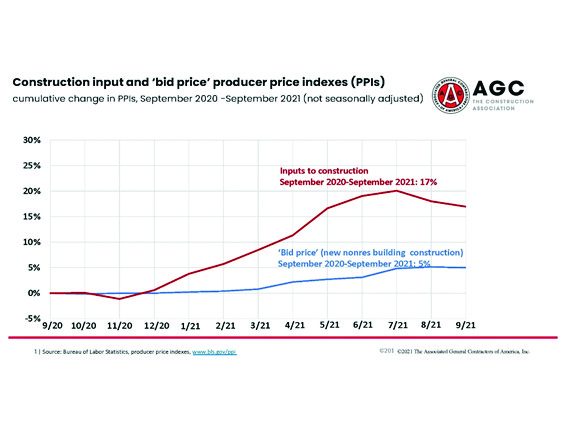Understanding and Estimating Escalation
Part One of a Two-Part Series
By Robert Wells (primary contributor), Thomas Gueville, Jay Carson, and Bill Canterbury (CEP Committee members of AACE’s Certification Board)
With the present global supply chain interruptions and rising inflation, there is an ever-increasing focus and concern for getting future project cost estimate escalation properly calculated and communicated. Project owners should understand and address the escalation risk exposures their projects may face in both the near and long terms. Ensuring your team is prepared to defend its cost escalation calculations is best done through conformance with the required skills and knowledge that all CEP certification holders possess.
Escalation
AACE International (AACE) Recommended Practice 10S-90 defines escalation as “[a] provision in costs or prices for uncertain changes in technical, economic, and market conditions over time. Inflation (or deflation) is a component of escalation.” [1]
AACE offers the Certified Estimating Professional (CEP) certification that signifies cost estimating professionals possessing this credential are aware of and competent in the required skills and knowledge of project cost estimating. Within AACE Recommended Practice 46R-11 are identified major project cost estimating skills, presented under Section 2.2: “Estimating Processes and Practices.” Among the skills listed are quantification, costing, pricing, risk evaluation and contingency determination. Project cost escalation is part of a skill subset called “Estimate Conditioning.” Determining cost escalation includes determining the dates of an estimate and its source data, the anticipated dates of project execution including pre-purchases and buyouts, and how to calculate the escalation based on the relevant estimate classification. Other factors in determining the basis for forecasting future rates of inflation or escalation can involve such components as a single price index, multiple indices, or an annual rate available through trusted industry sources and which will facilitate an accurate escalation estimate.
With Recommended Practice 58R-10 stating that “[i]n volatile times, it (escalation) may be the largest cost account in an estimate” [2], it is critical to the project stakeholders’ confidence in a cost estimate to know that escalation is being appropriately considered and properly calculated by estimating professionals.
Resources
AACE offers the following Recommended Practices (RP) for escalation quantification:
- Recommended Practice 58R-10, Escalation Estimating Principles and Methods Using Indices—This RP defines basic principles and methodological building blocks for estimating escalation costs using forecasted price or cost indices. [2]
- Recommended Practice 68R-11, Escalation Estimating Using Indices and Monte Carlo Simulation—This RP defines basic principles and methodological building blocks for estimating escalation using forecasted price or cost indices while also addressing uncertainty using Monte Carlo simulation. [3]
While there are excellent tools available for calculating escalation, using them properly is a different matter and should be performed by certified estimating professionals. Just like one can go to a hardware store and buy all kinds of wonderful tools, many weekend handypersons get in over their heads because they do not know how to properly select and use the appropriate tools.
One example of available industry data regarding cost inflation that can be applied in estimating escalation is shown in the following chart.

Next Steps
Understanding and Estimating Escalation-Part Two is coming in the February issue of Source. We will dive deeper into how escalation input data is obtained and used to quantify escalation following AACE’s Recommended Practices.
REFERENCES
- AACE International Recommended Practice 10S-90, Cost Engineering Terminology, AACE International Recommended Practices, September 30, 2021.
- AACE International Recommended Practice 58R-10, Escalation Estimating Principles and Methods Using Indices, AACE International Recommended Practices, May 25, 2011.
- AACE International Recommended Practice 68R-11, Escalation Estimating Using Indices and Monte Carlo Simulation, AACE International Recommended Practices, May 2, 2012.
Rate this post
Click on a star to rate it!
Average rating 4.1 / 5. Vote count: 16
No votes so far! Be the first to rate this post.

